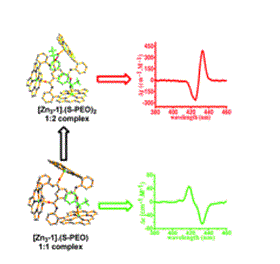Li Li Chuanjiang Hu Bo ShiYong Wang
a Key Laboratory of Organic Synthesis of Jiangsu Province, College of Chemistry, Chemical Engineering and Materials Science, Soochow University
b Jiangsu Key Laboratory of Technology for Polyamine, Polyol and Derived Polymers, Jiangsu Feixiang Group of Companies, Suzhou, P.R. China
Dalton Trans., 2016,45, 8073-8080
A new host–guest system is formed between a benzene tricarboxamide linked zinc trisporphyrinate and a chiral monoalcohol (1-phenylethylalcohol). CD spectra show the chirality induction and inversion processes, which are controlled by the corresponding 1:1 and 1:2 coordination complexes. The binding constants calculated by UV-vis and CD spectral data are much larger than that for [Zn(TPP)] (TPP = tetraphenylporphyrin). The crystallographic structure of the host–guest complex reveals that multiple intramolecular hydrogen bonds and π–π interactions could contribute to its high binding affinity to 1-phenylethylalcohol. The DFT calculations suggest that the spatial orientations of porphyrin moieties change from the 1:1 complex to the 1:2 complex. The chirality induction and inversion processes are rationalized by the summation of pairwise interactions among multichromophores according to pairwise additivity.

链接:http://pubs.rsc.org/en/Content/ArticleLanding/2016/DT/C6DT00570E#!divAbstract